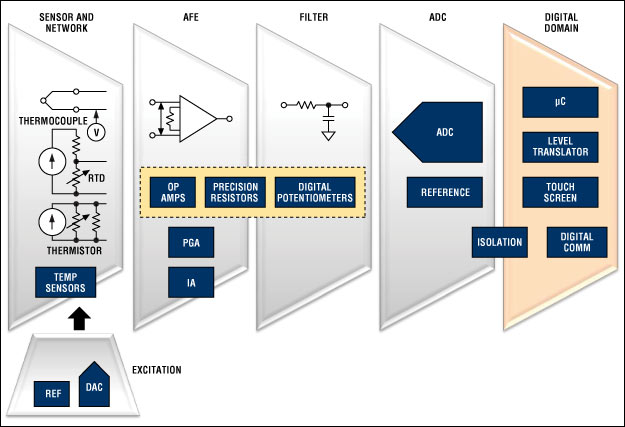Efficient signal acquisition is fundamental to applications ranging from industrial process control and measurement to high-speed communications and imaging. For designers, building an effective signal chain across this broad range of applications means balancing specifications of individual components within each stage to meet target performance levels of the signal chain as a whole.
In its most basic form, a signal acquisition circuit would be only one component: an analog-to-digital converter (ADC). For any practical application, however, the realities of realworld signal characteristics preclude such a simple approach and drive further requirements for signal conditioning.

The choice of the most suitable ADC — and therefore the choice of the required signal-conditioning components, is typically driven by requirements for signal conversion throughput and latency time (the time between the beginning of signal acquisition and the time when the ADC makes the corresponding data available on its outputs). Engineers can draw from various ADC architectures such as flash, successive-approximation-register (SAR), or sigma-delta (ΣΔ); each architecture providing inherent capabilities and limitations for achieving certain levels of throughput, latency, and overall performance.
Signal-conditioning circuits comprising amplifiers and filters are designed for the sole purpose of delivering a clean signal to the input of an ADC. Consequently, the complexity and performance specifications for those front end components derive largely from the characteristics and requirements of the ADC. Typically, sensors and transducers produce small-amplitude signals. Without amplification, these signals would allow use of only a portion of the full dynamic range of an ADC, most likely resulting in loss of fine detail due to limited ADC resolution and heightening the impact of converter quantization on error. Consequently, designers need an amplifier stage to increase the span of the input signal to match the full dynamic range of the ADC. Although the natural tendency is to find an amplifier with the highest possible performance specifications, engineers can dramatically reduce the cost of their designs by rigorously comparing amplifier specifications to the characteristics of the input signal, doing the same for resolution, as well as reviewing the overall functional requirements of the application.
The ability to create very sharp cutoff and notch filters using filtering algorithms running in software or on digital-signalprocessing
hardware also provides a significant opportunity to relax requirements in the analog signal chain. For example, engineers can select to shift filter complexity to the digital domain rather than increase the design’s footprint with more complex analog filtering components that might be required in a particular application.
Designers can find analog signal-conditioning and conversion components with performance specifications that can address the most demanding requirements for data acquisition. For many applications, however, the signal chain can be effective in meeting application requirements without requiring a full complement of components that all feature the best possible specifications. By matching ADCs to conversion requirements and signal-conditioning components to ADC specifications, engineers can design signal chains able to easily meet both performance and cost targets. This balance becomes even more important with the expected proliferation into the tens of billions of deeply embedded sensor systems feeding the Internet of Things (IoT); savings achieved at each stage of the signal chain translates into significant savings overall.
Advertisement
Learn more about Mouser Electronics





